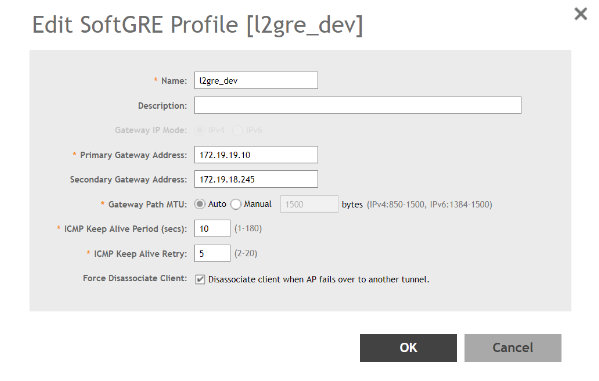Creating a Soft GRE Profile
You can configure the Soft GRE tunnel profile of the controller to manage AP traffic.
- Select Services & Profiles > Tunnels and Ports.
-
Select
Soft GRE and click
Create.
The Create Soft GRE Profile page is displayed.Figure 157 Creating a Soft GRE Profile

- Enter profile name and description.
- Under Gateway IP Mode, select IPv4 or IPv4 addressing.
- In the Primary Gateway Address field, enter the IP address or fully-qualified domain name (FQDN) of the primary gateway server.
-
In the
Secondary Gateway Address field, enter the IP address or fully-qualified domain name (FQDN) of the secondary gateway server.
NOTEIf the controller is unable to reach the primary gateway server, the controller automatically attempts to reach the secondary gateway address at the IP address specified by you.
-
For
Gateway Path MTU, set the maximum transmission unit (MTU) for the gateway path.
Select one of the following options:
- Auto: This is the default option.
- Manual: The transmission range is from 850 through 1500 bytes.
-
In the
ICMP Keep Alive Period field, enter the time interval in seconds.
NOTETime interval is the time taken by the APs to send a keepalive message to an active third party WLAN gateway. The range is from 1 through 180 seconds. The default value is 10 seconds.
-
In the
ICMP Keep Alive Retry field, enter the number of keepalive attempts.
NOTEKeepalive attempts are the number of attempts that the APs wait for a response from the active third party WLAN gateway before failing over to the standby WLAN gateway. The range is from 2 through 10 attempts. The default value is 5 attempts.
-
Under
Force Disassociate Client, enable
Disassociate client when AP fails over to another tunnel if you want to disassociate the client when AP fails over to another tunnel.
NOTEYou must select this option if you have enabled AAA Affinity while configuring the zone.
- Click OK.
You have created the Soft GRE profile.
NOTE
You can also edit, clone, and delete the profile by selecting the options
Configure,
Clone, and
Delete respectively from the
Soft GRE tab.
Parent topic: Working with Tunnels and Ports
